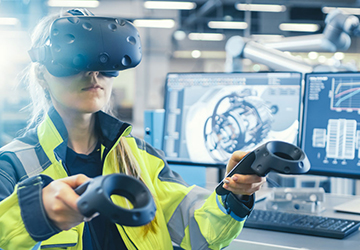In the ever-evolving world of technology, specific innovations possess the potential to redefine industries. Augmented Reality (AR) is an innovation that superimposes digital information onto the physical environment to enrich our experience. Adopting augmented reality in the commercial world has set off a chain reaction, ushering in cutting-edge advertising, instruction, and product creation strategies. Let's go deeper into the revolutionary potential of AR, the advantages of AR in the corporate sector, and the far-reaching effects of AR technology in many fields.
AR in Business: A Revolution in Interaction
The application of AR in business is not just a futuristic concept but a present-day reality. Industries ranging from retail to real estate are leveraging AR for an immersive customer experience:
● Retail: Imagine trying on clothes without physically wearing them or visualizing how a piece of furniture looks in your living room without buying it first. AR allows virtual try-ons and previews, making shopping more interactive and informed.
● Real Estate: Potential buyers or renters can now take virtual tours, with AR highlighting specific features of properties, giving them a richer understanding before making a decision.
● Healthcare: Medical professionals use AR for better visualization during procedures or for patient education, showcasing the potential of AR in business beyond traditional commercial sectors.

Benefits of Augmented Reality: Beyond the Gimmick
While AR is often associated with gaming or social media filters, the Benefits of augmented reality in the business world are profound and multifaceted:
● Enhanced Customer Engagement: AR creates interactive experiences, capturing customers' attention for longer, leading to deeper engagement and potentially higher sales.
● Improved Training & Development: AR can provide immersive training experiences for sectors like manufacturing or healthcare, simulating real-world scenarios. This not only enhances learning outcomes but also ensures safer training environments.
● Cost Savings: Through AR, businesses can provide virtual prototypes or demos, reducing the need for physical models and cutting costs.
● Personalized Experiences: By allowing consumers to receive personalized data and suggestions, AR helps businesses become more customer-focused.
AR Technology Impact: A Broad Spectrum of Change
The vastness of the AR technology impact is still unfolding, but its potential is undeniable:
● Supply Chain Management: Warehousing and inventory management can leverage AR to streamline operations. Workers wearing AR glasses can be directed efficiently to items, speeding up order fulfillment.
● Marketing & Advertising: Brands can create interactive campaigns where customers can engage directly with products. Imagine pointing your phone at a space and watching a car advertisement come to life in 3D.
● Tourism: Tourists can use AR apps to receive real-time information about historical sites, enhancing their travel experience.
● Remote Collaboration: Especially relevant in the age of remote work, AR can help teams collaborate in a shared virtual space, bridging geographical divides.
Emerging Applications of AR in Business:
Beyond the traditional applications, several emerging uses for AR in business signal the depth and breadth of its influence:
● Manufacturing and Design: Engineers and designers can visualize prototypes in real-world environments, allowing for real-time changes and enhancements and eliminating the barriers between conceptualization and realization.
● Maintenance & Repair: Field technicians can overlay AR data on machinery or equipment, helping them identify faults and guide them through complex repair processes without manual intervention.
● Museums & Interactive Learning: Museums are beginning to use AR to bring exhibits to life, providing a richer educational experience for visitors. Through AR, static exhibits become dynamic, telling stories beyond the confines of their physical display.
Unpacking the Benefits of Augmented Reality in Business Strategy:
The Benefits of augmented reality aren't just tactical—they're strategic, offering businesses the leverage to redefine entire customer journeys and operational blueprints.
● Branding Differentiation: In a market saturated with traditional advertising, AR offers brands a unique medium to stand out, providing immersive experiences that are memorable and shareable.
● Data Collection and Analytics: AR applications, especially in retail, offer a goldmine of user data. Businesses can track which products users interact with the most, the duration of interaction, and conversion rates. This information can be used to enhance advertising and development efforts.

AR Technology Impact: Beyond Immediate Applications:
To truly appreciate the impact of AR technology impact, one must look at its ripple effects and the secondary industries and innovations it spawns:
● AR Content Creation: As AR becomes integral to business, there's a burgeoning market for AR content creators, developers, and designers, leading to the evolution of new professional niches and training programs.
● Hardware Innovations: The demand for more refined AR experiences propels AR glasses, wearable tech, and holographic display advancements.
● Integration with Other Technologies: AR doesn't operate in a vacuum. Its integration with Artificial Intelligence, the Internet of Things (IoT), and 5G connectivity promises a synergy that could redefine how businesses operate.
Societal Implications of AR in Business:
As AR in business becomes increasingly pervasive, its societal ramifications extend beyond mere commercial advantages:
● Democratizing Knowledge: AR can break down barriers in education and training. For instance, complex processes or historical events can be visually broken down in an understandable manner for anyone, irrespective of their educational background.
● Cultural Integration: AR has the potential to bridge cultural gaps in the global marketplace. Consider a scenario where a user can point their AR device at a sign written in a foreign language and instantly view its translation or interact with a digital avatar explaining the cultural significance of a monument.
The Future Landscape Shaped by AR
Companies are investing more in augmented reality technology as they learn its many uses. While the initial introduction of AR was met with skepticism, its real-world applications have cemented its position as a formidable tool in the business arsenal.
Moreover, as AR hardware, like glasses and headsets, becomes more refined and accessible, we can anticipate an even more integrated use of AR in daily business operations. This shift, driven by both technological advancement and consumer demand, underscores the potential of AR to reshape entire industry landscapes.
In Conclusion:
Once a fringe technological concept, Augmented Reality has firmly embedded itself within the business tapestry. The revolutionary potential of AR technology as an interactive tool and a motivating force of creativity, customer engagement, and operational efficiency is highlighted by its influence across industries. As AR continues, businesses that adapt and embrace its capabilities stand to gain a competitive edge, heralding a future where digital and physical realities seamlessly converge.


